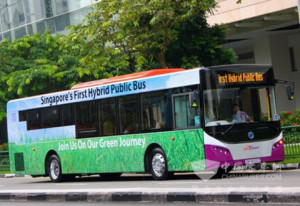
Known as a fuel cell and diesel hybrid bus respectively, the buses are part of a landmark trial by SBS Transit (Singapore Bus Services was renamed SBS Transit Ltd on 1 November 2001. The new name reflects our multi-modal status as we move from being just a bus operator to the provision of both bus and train services. ) which brings truly Green solutions to Singapore’s public transport industry for the first time.
The first green bus trials in the country in 2010, Mr. Teo Ser Luck, Senior Parliamentary Secretary for the Ministry of Transport & Community Development, Youth and Sports said: “This brings us a step closer towards creating a sustainable land transport system in Singapore.” He added that the collaboration between SBS Transit and local and foreign academics, as well as foreign bus manufacturers to test out new technologies in our local context “is a step in the right direction”.
The fuel cell bus, which has zero carbon emissions, is a collaborative effort between the Nanyang Technological University (NTU), Beijing’s Tsinghua University, China’s second largest bus manufacturer Higer, and SBS Transit. It is powered by two sources of energy – hydrogen and lithium-ion batteries. A fuel cell system housed on board the bus acts as an “energy converter” that transforms hydrogen into electricity, which powers the bus and charges the batteries at the same time. The bus, which will be garaged at NTU where a refuelling station is located, will be used to ferry delegates of the Singapore Youth Olympic Games, providing shuttle service in the Games Village located at NTU. Upon completion of the Games, it will be deployed to run on an SBS Transit route that caters to the NTU community.
The hybrid bus, which runs on both diesel and electricity, was brought in by ComfortDelGro Engineering in collaboration with Shanghai Sunlong Bus Company and Gemilang Coachworks of Malaysia. Fuel savings of up to 30% are derived by using electricity to power the bus. Essentially, electricity is generated through brake energy and stored in Lithium-ion batteries. The energy in the batteries is released to assist the engine in powering the vehicle. As a result, fuel consumption drops. The bus uses a parallel hybrid system that is developed by Eaton Corporation of the United States where a motor/generator is used to convert the electrical energy into mechanical energy and vice versa.